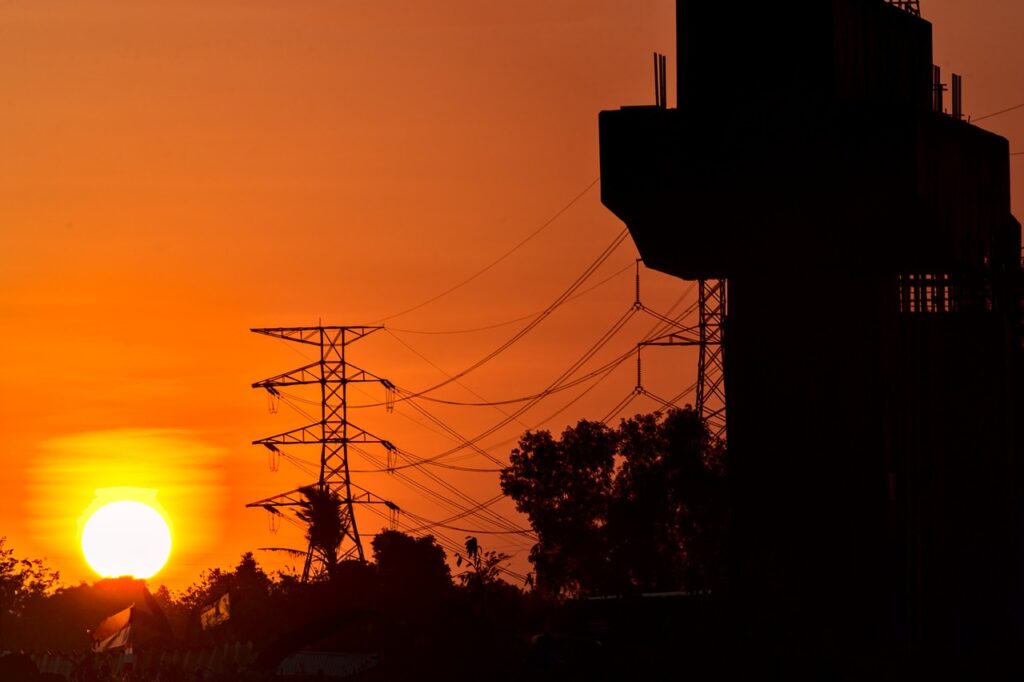Summer heat makes cooling a top priority, but it’s getting harder—and more expensive—to supply the electricity needed. Cooling and data centers are growing US electricity demand substantially, but the installation of new generation is not keeping pace, threatening both reliability and affordability.
Utilities and system operators must identify and implement short-term solutions that can maintain reliability and keep prices down while new infrastructure projects are built. A closer look at the Mid-Atlantic’s PJM Interconnection—which is struggling to meet heat and technology-driven demand increases—illustrates the challenges and opportunities for US transmission operators to build durable and affordable energy systems, even in the face of increasingly hot summers.
Rising prices in the US Mid-Atlantic
The PJM Interconnection—which serves 67 million people across thirteen states and the District of Columbia—completed its base residual auction for the year 2026–27, the first of several auctions designed to help ensure it has enough generating capacity to meet variable demand. Because electricity demand fluctuates throughout the year, consumers typically pay not only for the energy they use, but also to ensure there is adequate supply when demand spikes.
The auction clearing price reached a record high for the second year in a row—$329.17 per megawatt (MW)-day—equal to the cap imposed by the Federal Energy Regulatory Commission following a lawsuit led by Pennsylvania. Last year, the system-wide clearing price was $269.92, compared to $28.92 the year before. The massive price jump was driven by growing demand from data centers, changes to generator eligibility for the auction, interconnection delays, and grid constraints.
This spike hit consumers hard—in Washington, DC, for example, residents’ bills increased by an average of $21 in June 2025, nearly half of which is attributed to the capacity market. PJM estimates that this year’s auction will further increase bills by an additional 1.5 to 5 percent. Meanwhile, the operator is struggling to bring enough supply onto the grid to meet heat-related demand. PJM has issued several emergency maximum generation and load management alerts this summer, encouraging utilities and power generators to defer planned maintenance and maximize production, while advising customers to reduce consumption. In June, wholesale hourly real-time energy prices skyrocketed as high as $1,334 per megawatt-hour —110 times higher than PJM’s 2024 average.
Making PJM especially vulnerable to price increases is its high capacity of data centers in the country. The consultancy ICF predicts that PJM’s average electricity rates could skyrocket up to 40 percent within five years. PJM estimates that data centers will drive more than 90 percent of new power demand by 2030—therefore, finding short-term solutions to ensure adequate supply is critical.
Aging plants, few additions, and rising costs
PJM desperately needs additional capacity. Existing generators are retiring faster than new ones can replace them. The vast majority (72.1 percent) of retirements are aging, uneconomical coal plants, whereas new generators are almost entirely renewable projects. But because wind and solar electricity is intermittent, it requires greater capacity to replace dispatchable thermal generators. In its 2024 energy transition report, PJM projected that 41 gigawatts (GW) of retiring fossil fuel generation would need to be replaced with 84 GW of wind, solar, storage, and hybrid resources in a scenario accounting for existing state and federal policies through 2035.
However, PJM’s supply bottleneck is caused primarily by a long interconnection queue and drawn-out permitting processes, rather than a problem with capacity market pricing. Even when projects are built, stumbling blocks remain—in 2024, PJM built 4,500 MW of solar, 290 MW of wind, and 42.5 MW of storage, but 46,000 MW of generation capacity that cleared PJM’s interconnection queue remains nonoperational because projects face local opposition, supply chain problems, or financing issues.
The vast majority of newly proposed, planned, and constructed generators are renewable and do not receive a large share of the payments for having capacity available during peak demand hours. Wind and solar accounted for just 1 and 3 percent, respectively, of the generation that was committed in the auction and thus eligible for capacity payments, versus 45 percent natural gas, 21 percent nuclear, and 22 percent coal. Renewable resources receive revenue primarily from the energy market—the real-time price of power—because they are the most cost-competitive generation technologies. Generation resources of any kind can help address supply-demand imbalances, but these generation units are not being built at the pace required.
The capacity market provides revenue certainty to mostly dispatchable generation resources like nuclear and fossil fuels that typically generate electricity at a higher cost than renewables but are needed to buttress the grid and meet demand when it spikes. But the capacity auction has not yet sufficiently accelerated the buildout of new generation to meet system needs. As data center demand for constant power increases, so too will the cost of providing steady, baseload power. PJM’s market monitor estimates that data centers accounted for 63 percent of the price increase in the 2025/2026 auction—equivalent to $9.3 billion in additional costs that will be recovered from customers across the interconnection. Without proper management and diverse energy solutions, the growing costs attributable directly to data centers will be footed by households, rather than by data center owners, developers, the tech industry, and possibly public taxpayer funding.
Short and long-term solutions
PJM can take several actions to enhance grid reliability and affordability in the short term, including by expanding demand response programs, improving energy efficiency, installing grid enhancing technologies, continuing to expedite interconnection, and implementing artificial intelligence (AI) into grid operations. It must also devise new pricing strategies—a recent PJM proposal would exclude certain large-load customers from the capacity auction in exchange for being first to be curtailed if supply falls short, while Dominion Energy proposes creating a new customer class for data centers. Long-term, PJM must accelerate bringing new generators online, expand transmission infrastructure, and engage in long-term, coordinated, regional system planning.
Demand response and energy efficiency investments can help reduce peak demand pressures by incentivizing energy conservation with time-of-use rates. These programs may require the installation of new metering and billing systems so that both utilities and consumers can monitor and adjust usage in near-real time, as well as greater consumer awareness.
The most critical need is to upgrade existing transmission infrastructure and build additional lines to reduce congestion, deliver cheap power from neighboring systems, and improve reliability. Grid-enhancing technologies are the best short-term option, as they can vastly expand capacity for new generators and provide system operators with more flexibility, visibility, and control over the grid. Transmission line upgrades and expansions can enable the retirement of uneconomical energy assets by unlocking new or expanded points of connection for more affordable generators. Without an efficient process to connect additional generation capacity, federal officials can justify delaying coal and oil-fired plant retirements at a high cost to consumers on the basis of reliability.
Though data centers are a major driving force of the problem, AI tools can also be part of the solution by enhancing grid operators’ capabilities in tasks such as demand forecasting, fault detection, predictive maintenance, grid optimization, renewable integration, energy trading, customer analytics, cybersecurity, storage management, and automation.
Permitting reform and coordinated system planning are central to enabling the buildout of energy infrastructure and have gained bipartisan support. Utilities should deepen their regional collaboration on system planning in the short term to unlock mutual benefits. National efforts like the Department of Energy’s national transmission needs and planning studies should expand in line with the need for grid expansion in the longer term.
Finally, utilities should carefully consider cost allocation for new transmission projects when the benefits are nearly exclusive to data centers. An Institute for Energy Economics and Financial Analysis report found that West Virginia consumers were paying for grid upgrades that would benefit only new data center capacity, which is antithetical to the principles of the rate-making process.
Challenges ahead
In a region home to 67 million people and the most data center capacity in the United States, PJM’s inability to bring sufficient new generation online will threaten the reliability of the electricity system. But these issues are not exclusive to PJM.
The prospects for price relief are poor across the United States. The increasingly diverse energy mix, obstacles to new builds, and skyrocketing data center demand are compounded by a lack of federal support for the most competitive technologies. In addition to existing grid development and cost challenges, Energy Innovation estimates that the One Big Beautiful Bill will cause electricity rates paid by consumers across the United States to increase by 9 to 18 percent by 2035 and household energy costs to increase $170 annually by 2035.
Policymakers, utilities, businesses, and consumers must collaborate to implement both immediate and long-term solutions. Short-term actions like expanding demand response, adopting grid-enhancing technologies, and expediting interconnection processes can help bridge the gap while more substantial investments in generation and transmission come online. In the long term, accelerating the pace of generator installation and coordinated grid expansion will be essential to meet future demand, manage costs, and ensure the reliability of the electricity system.
Frank Willey is an assistant director at the Global Energy Center.
STAY CONNECTED
Sign up for PowerPlay, the Atlantic Council’s bimonthly newsletter keeping you up to date on all facets of the energy transition
ABOUT THE AUTHOR
RELATED CONTENT
OUR WORK

The Global Energy Center develops and promotes pragmatic and nonpartisan policy solutions designed to advance global energy security, enhance economic opportunity, and accelerate pathways to net-zero emissions.
Image: Sunset, power lines, twilight (Pisauikan, Pixabay,https://pixabay.com/pt/photos/pôr-do-sol-linhas-eléctricas-5508311/).




